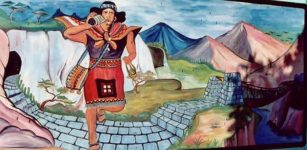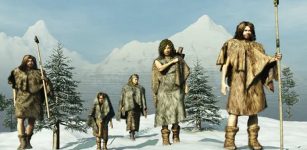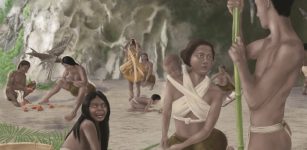Magnificent Pre-Dynastic City Of Sais And Its Lost Neglected Ruins
A. Sutherland - AncientPages.com - The history of Sais goes back to Egypt's pre-dynastic times (before 3100 BC). It was once a beautiful Egyptian city located in the western Egyptian delta along the right bank of the Rosetta Branch of the Nile River.
Left: Goddess Neith. Image credit: Osama Shukir Muhammed Amin FRCP(Glasg) - CC BY-SA 4.0; Right: Goddess Neith. Image credit: Right: Aegis of Neith, Twenty-sixth dynasty of Egypt - Museum of Fine Arts of Lyon. Rama - CC BY-SA 2.0 fr
Today, the only visible ruins of the city near the village of Sa al-Hadjar are dated to the Late New Kingdom (c.1100 BC).
There are no surviving traces of this town prior to this period of time, but it is scientifically attested that the history of Sais goes back to pre-dynastic times. From the 3rd millennium BC, Sais was a famous economic, political, and religious center of the goddess of war and hunting, Neith, whose temple was to be erected by the founder of the first Dynasty.
Known as a center for science and the arts, the city was first mentioned in inscriptions of the archaic period. However, it played an important role in all historical periods and was most important in the late ages. It was then the state capital during the reign of the XXIV and XXVI dynasties.

Herodotus and some other ancient sources confirm that Sais was a prestigious city of northern Egypt about 3100 BC, full of magnificent buildings and royal crypts, and the wives of the rulers of the first Dynasty (Merneit, Meritneit) had come from Sais.
Amasis, who ruled for 44 years and made many contributions to the country, was probably the 5th ruler of Egypt during the 26th Dynasty and has been called the last great Egyptian Pharaoh.
He established himself at Sais in Northern Egypt, and there – like in many other places in Egypt – he ordered the building of monumental buildings, including his tomb at Sais, which was unfortunately never discovered. Still, according to Herodotus' description, the tomb was beautiful:
'It is a great cloistered building of stone, decorated with pillars carved in the imitation of palm-trees, and other costly ornaments. Within the cloister is a chamber with double doors, and behind the doors stands the sepulchre…"
In the age of the Ptolemies (323 to 30 BC), Sais was an important center.
Ancient Sais was the center of the cult of the goddess of war and hunting, Neith, the patron goddess of Sais, a great protector of the people of the land, and the most accomplished mediator between humanity and the gods. From the Late Period (1000 BC onwards), the Neith temple was a center of pilgrimage.
 Head of Amasis II. Saite period, 26th Dynasty, c. 550 BCE. From Egypt. Neues Museum, Berlin, Germany. Greywacke, ÄM 11864. source
Head of Amasis II. Saite period, 26th Dynasty, c. 550 BCE. From Egypt. Neues Museum, Berlin, Germany. Greywacke, ÄM 11864. source
However, Sais had several other temples dedicated to the creator god Atum and one dedicated to the Egyptian Lord of the Underworld and Judge of the Dead, Osiris.
According to Herodotus, the grave of Osiris was located at Sais. The Temple of Sais had a medical school associated with it. The medical school at Sais had many female students and apparently women faculty, mainly in gynecology and obstetrics.
An inscription from the period survives at Sais and reads:
"I have come from the school of medicine at Heliopolis and have studied at the women's school at Sais, where the divine mothers have taught me how to cure diseases…".
Many kings of Sais were clever men; among them was King Nekau of the Twenty-sixth Dynasty, who ruled for 15 years and sent an expedition that circumnavigated Africa. King Nekau was the ruler who started the construction of a canal from the Nile to the Red Sea, later completed by the Achaemenid king Darius I.
 Relief of Psamtik I making an offering to Ra-Horakhty (Tomb of Pabasa). source
Relief of Psamtik I making an offering to Ra-Horakhty (Tomb of Pabasa). source
Necho I, appointed by the Assyrian king Esarhaddon, extended his jurisdiction over the Delta and Memphis after his conquest of Egypt in 671 BC. His son Psamtik I successfully reunited the whole of Egypt and founded the twenty-sixth Dynasty. Later, the successive kings of this Dynasty enlarged and embellished Sais.
The Persians invaded Egypt in 525 BC, just after Psamtek III became king. The fate of the city of Sais is not precisely known, but it is known that after ascending the throne, the Persian king Cambyses marched against Egypt, where he ruined the tomb of Amasis (also known as Ahmose II, which means "The Moon is Born, Son of Neith"). Moreover, he also thoroughly destroyed the city, including several temples.
The city was never subject to systematic archaeological research, and in ancient times, it was better known from historical sources of Herodotus and Strabo and descriptions of travelers.
Written by – A. Sutherland - AncientPages.com Senior Staff Writer
Updated on January 27, 2024
Copyright © AncientPages.com All rights reserved. This material may not be published, broadcast, rewritten or redistributed in whole or part without the express written permission of AncientPages.com
Expand for referencesMore From Ancient Pages
-
 Superhighways Traveled By The First Australians Reveal A 10,000-Year Journey Through The Continent – New Study
Archaeology | Feb 3, 2023
Superhighways Traveled By The First Australians Reveal A 10,000-Year Journey Through The Continent – New Study
Archaeology | Feb 3, 2023 -
 Unknown 2,000-Year-Old Settlement Hidden In The Polish Tuchola Forest Revealed By LIDAR
Archaeology | Feb 18, 2019
Unknown 2,000-Year-Old Settlement Hidden In The Polish Tuchola Forest Revealed By LIDAR
Archaeology | Feb 18, 2019 -
 Lachit Bhorphukan: Hero From Assam Among Famous Warriors Who Stopped Mughals From Conquering Northeast India
Featured Stories | Dec 28, 2016
Lachit Bhorphukan: Hero From Assam Among Famous Warriors Who Stopped Mughals From Conquering Northeast India
Featured Stories | Dec 28, 2016 -
 Has The Mythical Long-Lost Underwater Ancient Land Of The King With Three Crowns Been Found?
Featured Stories | May 2, 2025
Has The Mythical Long-Lost Underwater Ancient Land Of The King With Three Crowns Been Found?
Featured Stories | May 2, 2025 -
 On This Day In History: Leon Trotsky Was Assassinated – On August 20, 1940
News | Aug 20, 2016
On This Day In History: Leon Trotsky Was Assassinated – On August 20, 1940
News | Aug 20, 2016 -
 Evidence Foreigners Fought Alongside Ancient Greeks Is Challenging Millennia Of Military History
Featured Stories | Jun 1, 2022
Evidence Foreigners Fought Alongside Ancient Greeks Is Challenging Millennia Of Military History
Featured Stories | Jun 1, 2022 -
 First Carbon-Based Paleolithic Paintings Found In Font-De-Gaume Cave, France Could Be 19,000 Years Old
Archaeology | Dec 29, 2023
First Carbon-Based Paleolithic Paintings Found In Font-De-Gaume Cave, France Could Be 19,000 Years Old
Archaeology | Dec 29, 2023 -
 Chang’e: Chinese Goddess Of Moon And Immortality
Chinese Mythology | Aug 7, 2019
Chang’e: Chinese Goddess Of Moon And Immortality
Chinese Mythology | Aug 7, 2019 -
 Why Was Grette The Strong, Icelandic Poet And Warrior Afraid Of Darkness?
Featured Stories | Sep 30, 2023
Why Was Grette The Strong, Icelandic Poet And Warrior Afraid Of Darkness?
Featured Stories | Sep 30, 2023 -
 Inca Communication: Mailmen Of The Inca Empire Were Fast Roadrunners
Ancient History Facts | Mar 20, 2016
Inca Communication: Mailmen Of The Inca Empire Were Fast Roadrunners
Ancient History Facts | Mar 20, 2016 -
 Ancient Mystery From The Age Of Taurus And The Murdered Astronomer – Overlooked Secret In The North – Part 1
Ancient Mysteries | Oct 30, 2019
Ancient Mystery From The Age Of Taurus And The Murdered Astronomer – Overlooked Secret In The North – Part 1
Ancient Mysteries | Oct 30, 2019 -
 Pharaoh Psusennes I Was Buried In The Silver Coffin Decorated With Gold
Featured Stories | Jan 25, 2021
Pharaoh Psusennes I Was Buried In The Silver Coffin Decorated With Gold
Featured Stories | Jan 25, 2021 -
 Hunter-Gatherers Of Baltic Region Had Culturally Distinct Cuisines Related To Traditions
Archaeology | Apr 23, 2020
Hunter-Gatherers Of Baltic Region Had Culturally Distinct Cuisines Related To Traditions
Archaeology | Apr 23, 2020 -
 Mystery Of The Lavau Celtic Prince And The Beautiful Ancient Artifacts Hidden In His 2,500-Year-Old Tomb
Archaeology | Jun 5, 2017
Mystery Of The Lavau Celtic Prince And The Beautiful Ancient Artifacts Hidden In His 2,500-Year-Old Tomb
Archaeology | Jun 5, 2017 -
 Did Neanderthals And Modern Humans Meet In The Czech Republic 50,000 Years Ago?
Archaeology | Jun 17, 2017
Did Neanderthals And Modern Humans Meet In The Czech Republic 50,000 Years Ago?
Archaeology | Jun 17, 2017 -
 The Invisible Plant Technology Of The Prehistoric Philippines
Archaeology | Jul 1, 2023
The Invisible Plant Technology Of The Prehistoric Philippines
Archaeology | Jul 1, 2023 -
 New Giant Geoglyph Of Orca With Mysterious Symbols And A ‘Trophy Head’ Found In Nazca Lines
Archaeology | Nov 18, 2017
New Giant Geoglyph Of Orca With Mysterious Symbols And A ‘Trophy Head’ Found In Nazca Lines
Archaeology | Nov 18, 2017 -
 Unique Ancient Figurine Puzzles Scientists – Was She An Unknown Pre-Historic Water Goddess?
Archaeology | Jul 21, 2022
Unique Ancient Figurine Puzzles Scientists – Was She An Unknown Pre-Historic Water Goddess?
Archaeology | Jul 21, 2022 -
 Mystery Of The Anonymous God Of Palmyra Finally Solved By Scientists
Archaeology | Jun 21, 2022
Mystery Of The Anonymous God Of Palmyra Finally Solved By Scientists
Archaeology | Jun 21, 2022 -
 Early Humans In Europe Were Making Fires At Least 250,000 Years Ago – New Study
Archaeology | May 18, 2023
Early Humans In Europe Were Making Fires At Least 250,000 Years Ago – New Study
Archaeology | May 18, 2023

